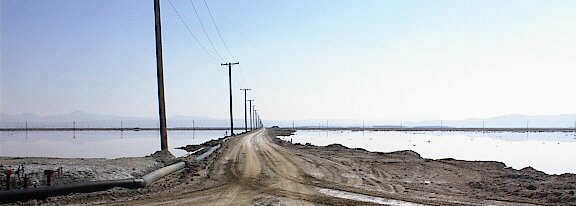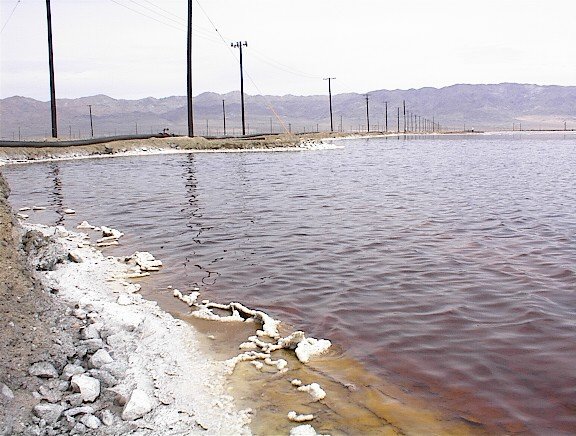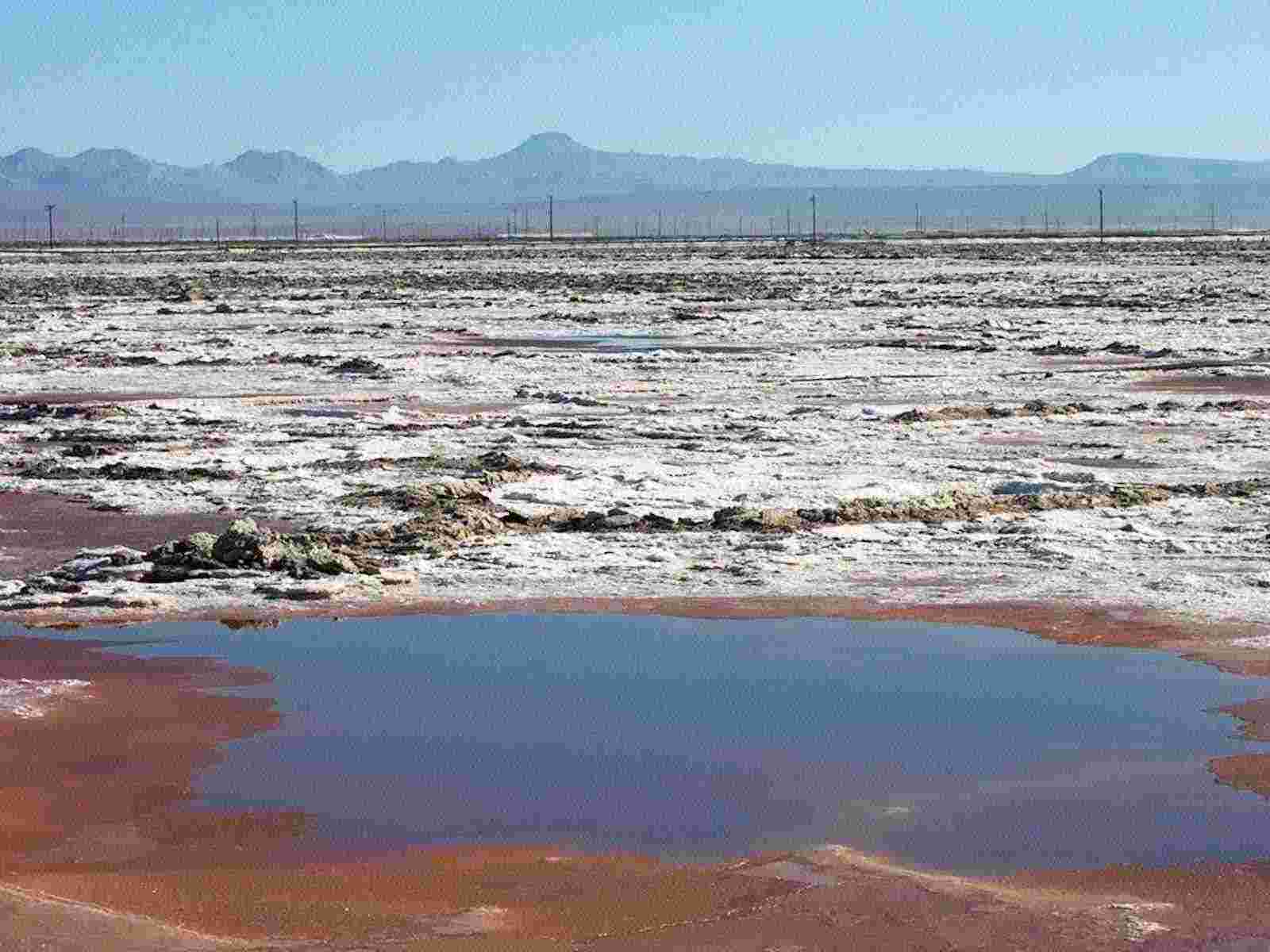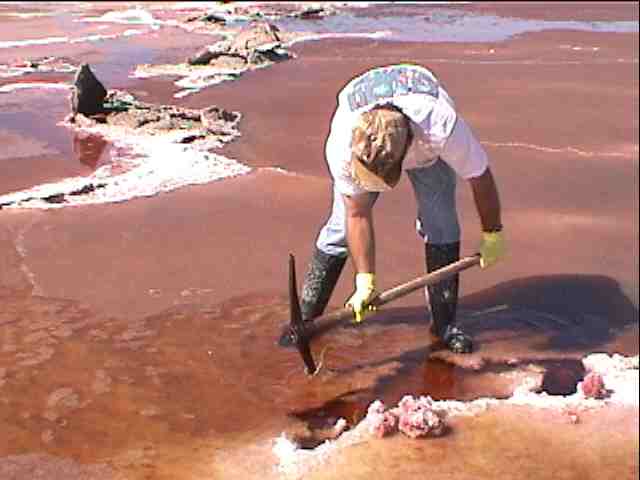Searles Lake Gem and Mineral Society
GEM-O-RAMA
See Flyer
for dates and times
Pink Halite/Brine Pools
Field
Trip
Pink
Halite Specimens Friday, Dealer Field Trip
For many visitors, the pink halite field trip
is the highlight of the weekend.
This field trip starts new each year because the field trip area
floods
each winter. Any pink halite
in the collecting area left behind after last year's show is dissolved
in this water. The photograph
below, looking south from the main road intersection on the field trip,
shows the collecting on
February 26, 2000. Clearly, both sides of
North-South Road are flooded with no dry surface.

As shown in the picture below, taken May 14,2000 at the same corner
as above, the halite is just
starting to crystallize, but mostly
in splash areas with still nothing in the deeper pools. As can be
seen,
there has still not been enough sun and warm weather to produce the
natural
pink color.

Over the course of the hot, dry summer, the
water
evaporates from the surface of these ponds,
providing an opportunity for
salt crystals to grow slowly. Under these slow crystallization
conditions,
individual salt crystals can become quite large - up to 2 inches across.
Surprising as it seems, microscopic halophilic
(salt loving) bacteria live in this highly concentrated
brine and when
they die, they contribute dark red coloring matter to the brine.
As summer wanes,
the brine turns a darker and darker shade of red, occasionally
reaching the color of a fine port or
burgundy wine. Occasionally,
the salt crystals trap some of this red matter as they grow, so that
you
can find salt with a wide range of colors, from pure white to pale pink
to a dark cranberry
magenta. Occasionally, some of the halite develops
a pale green or blue tint as well, the result of
a different bacteria,
this one colored blue-green. For a complete discussion of the
various
halophilic
bacteria, click on Why
Owens Lake Is Red . This article is from the internet
magazine
DesertUSA
and the link is provided with the approval of the publisher.
During especially hot days the halite may
dissolve
to be replaced by the mineral burkeite, and this
will form as a pseudomorph
after the halite it replaces. In many ledge deposits, nahcolite will be
the
dominant mineral in the hard matrix.
The best halite crystals will be found where the crystals are
actively
growing. This means that they
must be in brine. The largest crystals form on the underside of
an overhanging ledge. In those
places exposed to the surface, small crystals continually falling from
the surface cover the salt,
thereby preventing the growth of large crystals. Therefore, look for a
brine
pool that has overhanging
ledges (even a slight overhang will be enough
to form good specimens). An example of a ledge
beneath the brine
surface
can be seen on the right side of the picture below. The pink
halite on
the left was from this left side of this ledge.

In their quest for good ledges experienced
collectors will search both open brine pools and the
pressure ridges which
can be recognize by their upturned summits, like a miniature mountain
range.
Another tip: use your fingers to determine whether-or-not crystals are
present - if you
can't feel them, they aren't there, so digging there will
be a waste of time. But be careful, many
of these crystals are very
sharp and surface skin cuts can happen. If you are especially
interested
in the darkest red color possible, look for the brine pool with the
darkest
red color in the brine.
As a summary, spend enough time looking to
find good specimens some before starting to dig.

Once you have found what you think may be a
good
specimen, you must break off the ledge in
order to collect it. A pick can also be used to chop off
specimens from a shallow ledge, as shown
below. But a
heavy bar (1 inch solid steel, 6 feet long, with a 2 inch blade) is
quite
effective for
chopping through a tough, nahcolite ledge. These can
be rented at the SLG&MS General Store
in the show building.
At least sacrificial tennis shoes are necessary, although I prefer
to wear
hip waders when I collect
for the club.


Although small plates can be easily collected
near the edges of the brine pools, if you want the
big boys, you'll have
to work hard. Here, Chuck Bennett shows us his famous "big bar"
technique.
The yellow and green crust is mostly massive nahcolite, and it can be
very
tough.
Go to Pink
Halite Specimens
Go to Gem-O-Rama
Site Map
Searles Lake Gem and Mineral Society
P. O. Box 966
Trona, CA 93592-0966
Phone (760) 372-5356

| Home
| Home
Site Map | Revised 11/08/2019
All contents of this web page are the property of
the
Searles Lake Gem & Mineral Society.
Reproduction or other uses of any of these contents
without the written permission of the owner is prohibited.
If you want to use any of the contents, contact the
SLG&MS at any of the above.




